This set of Electrical Measurements & Measuring Instruments Multiple Choice Questions & Answers (MCQs) focuses on ” Advanced Problems on CRT and CRO”.
1. A recorder is a device ________
a) An indicating instrument which displays a time-varying signal
b) Whose function is to record the value of the quantity as it is being measured
c) Which records electrical and non-electrical quantities or relates two signals to each other as a function of time
d) Which records the value of the quantity measured as well as the electrical and non-electrical quantities as a function of time
View Answer
Explanation: A recorder is a device which record the value of quantity as it is being measured. It records electrical and non-electrical quantities or relates two signals to each other as a function of time.
2. In a dual slop integrating type digital voltmeter, the firs integrating is carried out for 10 periods of the supply frequency of 50 Hz. If the reference voltage used is 2 V, the total conversion time for an input of 1 V is?
a) 0.01 s
b) 0.05 s
c) 0.1 s
d) 1 s
View Answer
Explanation: In a dual slope integrating digital voltmeter,
\((\frac{t_1}{t_2})\) Vin = Vref
Where, t1 = first integration time = 10 × \(\frac{1}{50}\) = 0.25
But Vin = 1 V and Vref = 2 V
∴ t2 = \(\frac{V_in t_1}{V_{ref}}\) = 0.1 s.
3. The source of emission of electrons in a circuit is ______________
a) p-n junction diode
b) a barium and strontium oxide coated cathode
c) accelerating anode
d) post-accelerating anode
View Answer
Explanation: The source of focused and the accelerated electron beam is the electron gun. The electron gun which emits electrons forms them into a beam consisting of a heater, a cathode, a grid, a pre-accelerating anode, a focusing anode and an accelerating anode.
4. A CRO can display _________
a) AC signals
b) DC signals
c) Both AC and DC signals
d) Time-invariant signals
View Answer
Explanation: A Cathode Ray Oscilloscope cannot measure or display Time invariant signals. However, it can measure both AC and DC signals.
5. X and Y plates of a CRO are connected to unequal voltages of equal frequency with phase shift of 90°. The Lissajous figure on the screen will be?
a) Circle
b) Straight line
c) Ellipse
d) Figure of eight
View Answer
Explanation: The pattern observed on the CRT, when two sinusoidal signals are applied to the X-X and Y-Y plates of the CRT are known as Lissajous pattern.
sin φ = \(\frac{y_1}{y_2} = \frac{X_1}{X_2}\)
Here, the voltages are unequal and frequencies are equal with a phase shift of 90°. Therefore the Lissajous figure on the screen will be an ellipse.
6. To the Y input of a CRO, we feed a signal defined by 10sin100t, to the X-input, we feed signal 10cos100t. The gain for both X channel and Y channel is the same, the screen will show?
a) Sinusoidal signal
b) A straight line
c) An ellipse
d) A circle
View Answer
Explanation: The pattern observed on the CRT, when two sinusoidal signals are applied to the X-X and Y-Y plates of the CRT are known as Lissajous pattern.
sin φ = \(\frac{y_1}{y_2} = \frac{X_1}{X_2}\)
∴ Screen will show a circle.
7. A CRO uses _________
a) Electromagnetic focusing
b) Electrostatic focusing
c) Both Electrostatic and Electromagnetic focusing
d) No focusing technique
View Answer
Explanation: A Cathode Ray Oscilloscope always using the focusing technique for its operation. Electromagnetic focusing is used by the Cathode Ray Tube. However, the Cathode Ray Oscilloscope employs Electrostatic focusing.
8. A CRO probe has an impedance of 500 kΩ in parallel with a capacitance of 10 pF. The probe is used to measure the voltage between P and Q as shown in the figure. The measured voltage will be?

a) 3.53 V
b) 3.47 V
c) 5.54 V
d) 7.00 V
View Answer
Explanation: XC = \(\frac{1}{jCω} = \frac{-j}{2 × 3.14 × 100 × 10^3 × 10 × 10^{-12}}\)
Applying KCL at node,
\(\frac{V_a-10}{100} + \frac{V_a}{100} + \frac{V_a}{500} + \frac{V_a}{-j159}\)
∴ Va = 4.37∠-15.95°.
9. The two inputs of a CRO are fed with two stationary periodic signals. The figure changes from ellipse to circle and back to ellipse with its major axis changing orientation slowly and repeatedly. The following inference can be made from this.
a) The signals are not sinusoidal in nature
b) The amplitudes of the signals are very close but not equal
c) The signals are sinusoidal with their frequencies very close but not equal
d) There is a constant but small phase difference between the signals
View Answer
Explanation: X = A sinωt
Y = A sin (ωt-∅t)
Phase difference = ∅t
For ellipse, A1 ≠ A2
For circle, A1 = A2
Hence, there is a constant but small difference between the signals.
10. An oscilloscope indicates ___________
a) The peak to peak value of the voltage
b) DC value of the voltage
c) Rms value
d) Average value
View Answer
Explanation: The oscilloscope can measure not only the DC value but also the AC value. The RMS value cannot be measured by the oscilloscope. Similarly, the average value is also not measured. Therefore the peak to peak value of the voltage is measured.
Sanfoundry Global Education & Learning Series – Electrical Measurements.
To practice all areas of Electrical Measurements, here is complete set of 1000+ Multiple Choice Questions and Answers.
If you find a mistake in question / option / answer, kindly take a screenshot and email to [email protected]
